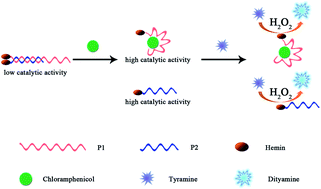Aptamer-based fluorometric determination of chloramphenicol by controlling the activity of hemin as a peroxidase mimetic†
Abstract
A method for the aptamer-based determination of chloramphenicol (CAP) was developed by exploiting the peroxidase mimicking activity of hemin. The method includes two hemin-modified DNA probes termed P1 and P2. P1, which was modified at its 5′ end with one hemin monomer, contains the CAP-binding sequence. The hybridization between P1 and P2 brings the two hemin monomers in close proximity, resulting in the formation of a hemin dimer with low peroxidase mimicking activity. The duplex structure was dehybridized in the presence of CAP. The formed hemin monomer featured a strong peroxidase mimicking activity and catalyzed the conversion of non-fluorescent tyramine into fluorescent dityramine by hydrogen peroxide. Fluorescence (with an excitation/emission maxima at 320 and 410 nm, respectively) increased linearly in the 0.1 ng mL−1 to 10 ng mL−1 CAP concentration range. The detection limit based on the 3σ/k criterion reached 0.07 ng mL−1. The proposed assay was successfully employed for CAP detection in (spiked) honey samples with recoveries of 94.3–117.2%. Given its high sensitivity and good stability, this method shows potential in providing a platform for antibiotic detection.



 Please wait while we load your content...
Please wait while we load your content...